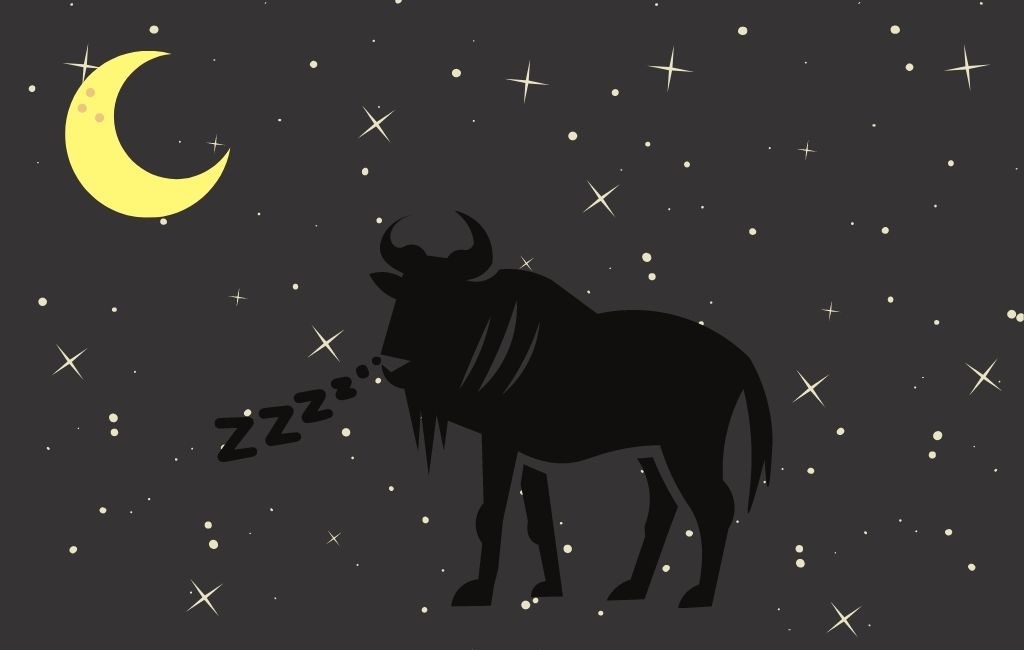Sleep is a source of endless fascination for some scientists. It is a highly conserved physical cycle across animal evolution, and there are very few creatures that can survive without it. For humans, a lack of sleep is debilitating and, eventually, fatal. Yet despite its enormous importance, we are far from understanding the diverse processes and mechanisms behind sleep, and scientists are regularly revealing fascinating similarities and differences in mammal sleep “architecture”. New research demonstrates that wildebeest sleep just 4.5 hours per day.
The new study, compiled by researchers at the School of Anatomical Sciences at the University of Witwatersrand, recorded the sleep of two free-roaming male wildebeest in Dinokeng Game Reserve in South Africa. Most studies examining animal sleep are conducted in controlled environments (zoos or laboratory situations). This is one of the few carried out under relatively natural conditions.

There are two significant stages of sleep – rapid-eye-movement sleep (REM) and slow-wave or non-rapid-eye-movement sleep (non-REM) – which alternate in a cycle that may be repeated several times during a sleep episode. The way these cycles are repeated, their duration and phasing (in total, the sleep architecture) varies considerably in different mammal species. The authors suggest that comparative studies could provide insight into the function and evolution of sleep.
To examine the wildebeest sleep architecture, the scientists used two different monitoring methods: polysomnography (PSG) and actigraphy (ACT). The PSG method is more invasive than ACT and requires the surgical implantation of electrodes on the brain’s surface. ACT is a more modern method widely used in human sleep monitoring but has not been thoroughly tested in other contexts. Part of this research aimed to test the concordance between the two methods in the hope that the less invasive ACT method could eventually replace PSG (which is currently considered the “gold standard” in sleep monitoring).

The researchers found that wildebeest slept for around 4.5 hours a day, with 4.3 hours spent in non-REM sleep and just 18 minutes in REM sleep. Their main sleep bout was between the hours of 03.30 and 04.30 in the morning. These results appear to be in line with other Artiodactyls (even-toed ungulates), though there is little comparative research on wild, free-roaming herbivores. The only other phylogenetically comparable wild mammals that have been studied are giraffes and Arabian oryxes.
Though total sleep time is consistent across both wild and domestic Artiodactyl species, the study points to a possible trend in the percentage of REM sleep. Domestic animals appear to have a substantially higher proportion of sleep occupied by REM when compared to wild species. This could indicate that domestication may have been a factor in increasing REM sleep. The authors also suggest drawing an analogy between humans and chimpanzees. Though chimpanzees have a longer average sleep time per day than the average human (10.8 hours compared to 8 hours), the chimpanzee’s total REM sleep is still less than a human’s (97 minutes compared with 114 minutes).
The study also shows a fair amount of concordance between PSG and ACT techniques but suggests that further refinement will be necessary before ACT can be used as a suitable replacement. However, if certain adjustments can be made, ACT could prove to be a far more viable alternative for monitoring sleep in natural settings. Most importantly, it could provide a technique for long-term monitoring. At present, we have little idea about whether or not sleep changes under different environmental conditions, during the breeding or birthing season or when wildebeest are migrating long-distance. Validating ACT methodology would open up opportunities to study sleep in a multitude of large mammalian species.
Dr Illke Malungo, the lead author of the study, plans to build up a vast body of data for comparison purposes by conducting similar research on more mammal species, including predators. It will be interesting to see how claims that lions sleep up to 22 hours every day will bear up under scientific scrutiny…![]()
The full study can be accessed here: “Sleep in two free-roaming blue wildebeest (Connochaetes taurinus), with observations on the agreement of polysomnographic and actigraphic techniques”, Malungo, I., et al., (2020), IBRO Neuroscience Reports
To comment on this story: Login (or sign up) to our app here - it's a troll-free safe place 🙂.![]()






